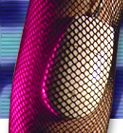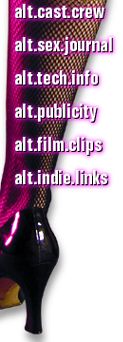The
screenplay: Three by Five 2.0 & Final Draft 4.1.6.
Three by Five mimics
a 3x5 file card layout where you can assign a moment or scene
within it's own little "card", then these can be arranged
around in different order once you've got the major stuff
worked out. (Note: this feature is now in Final Draft 5.0)
I created most of the scenes and almost all of the plot points
before I did any dialog writing. Once I worked out the motivation
or joke (i.e. ending) of each scene, it was just a matter
of getting to the point as quickly as possible with the fewest
number of characters. How anyone sits down and just startswriting
something without any long pre-thinking is just amazing to
me.
Wrote the screenplay
on a Radius 8100/110 Macintosh clone with Final
Draft 4.1.6. Final Draft is nice because it does all the
standard screenplay formatting for you. It also remembers
character names so you don't have to keep re-typing them either.
Started writing version 1.0 of the screenplay September
29, 1998. I completed the final version (v 4.0) around
January, 20,
2000. I completed the first version of the screenplay
(100 pages) after about 6 months of writing on a fairly steady
basis. (1 or 2 scenes a day.) I took about another year of
re-thinking and some additional writing to get it to a point
of where I could live with it. I go into more detail on the
writing aspect in my alt.sex journal.
Most of the story
is based my experiences on dating from my 20's to early 30's.
Some scenes are totally non-fictional. (Getting a phone slammed
into my face after telling a woman that she was the very first
woman I've ever gotten a phone number from in a bar.)
Most
of the male leads were cast from my friends. (I wrote many of
the parts with them in mind.) I did an electronic casting call
on the New England
Film.com and the Mass
Film Office sites. If I personally didn't know someone,
I found everyone else either online or through a cast referral.The
money for the production (approx. $15,000) came from my wallet.
(Earned from doing corporate video
production. This total includes the cost of the Super 16mm
camera, film stock, developing/video transfer, DAT machine and
expensive microphone.)
Production
Equipment: The film
was shot with an Eclair ACL Super 16mm camera.
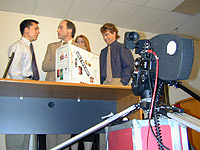 The
Eclair ACL is a crystal sync camera that can record sync sound.
(check out my Eclair ACL webpage.)
I bought this puppy for $4800 from a guy on ebay. (Journal
entry April 29, 1999) I wanted to own a camera so I could
(in the long run) save time and camera rental fees. I also
wanted the freedom to be able to do some quick, pick-up shots
without the hassle of renting a camera. The Eclair ACL cost-wise
was a good compromise. To even buy a used Aaton or Arri crystal
sync Super 16mm camera will START at $20,000. (If you can
even find one.) Your other option would be to find a used
Arri BL for around the same price. It's my understanding that
these cameras as fairly noisy and are a complete bitch to
do hand-held work with. Still another option would be to get
an Eclair NPR. (A little more awkward to hand hold, but still
a nice camera for the money. These pre-date the ACL.) The
last option is a Cinema Products CP-16 camera. It's my understanding
that these cameras were used a lot for news gathering back
in the 70's. I haven't heard of any being converted to Super
16mm. The final note on the ACL is that if you put a 200'
magazine on the back, you could sneak into ANYWHERE and film
with them because they are so small compared to the others. The
Eclair ACL is a crystal sync camera that can record sync sound.
(check out my Eclair ACL webpage.)
I bought this puppy for $4800 from a guy on ebay. (Journal
entry April 29, 1999) I wanted to own a camera so I could
(in the long run) save time and camera rental fees. I also
wanted the freedom to be able to do some quick, pick-up shots
without the hassle of renting a camera. The Eclair ACL cost-wise
was a good compromise. To even buy a used Aaton or Arri crystal
sync Super 16mm camera will START at $20,000. (If you can
even find one.) Your other option would be to find a used
Arri BL for around the same price. It's my understanding that
these cameras as fairly noisy and are a complete bitch to
do hand-held work with. Still another option would be to get
an Eclair NPR. (A little more awkward to hand hold, but still
a nice camera for the money. These pre-date the ACL.) The
last option is a Cinema Products CP-16 camera. It's my understanding
that these cameras were used a lot for news gathering back
in the 70's. I haven't heard of any being converted to Super
16mm. The final note on the ACL is that if you put a 200'
magazine on the back, you could sneak into ANYWHERE and film
with them because they are so small compared to the others.
My camera was modified
to shoot Super
16mm. Super 16 is wider than traditional 16mm film, it
has a similar frame aspect ratio as 35mm film and hi definition
TV. Super 16mm can be "blown up" to 35mm better than conventional
16mm. You can also shrink (blow DOWN) this wide frame into
a smaller 16mm frame for the purposes of film festival showings.
Super 16mm will fit nicely onto a hi definition television
picture in the future. (Regular 16mm will have to be cropped
or be letterboxed vertically.) Why anyone argues against shooting
Super 16mm is a short-sighted nit-wit in my book.
I've also added
an
AZ Spectrum video tap to the camera. This put me out another
$1600, but was well worth it. (I sold a video deck to come
up with the necessary "scratch." It's a weird feeling selling
newer technology (video) to come up with the money to support
older (film) technology.) If you are a video guy who's accustomed
to looking at a monitor than peering through a viewfinder,
then spring for one of these. The only weird thing is the
B&W camera records what the viewfinder sees, so when the camera
is running, you are seeing the shutter fly past the frame,
so the image gets darker and has a noticeable flicker.
03/02/01 - An
update on the ACL: If you're thinking of getting one of
these puppies on ebay, make sure you buy an ACL II! An ACL
II comes with: 400' magazines and the variable speed motor
which can pull these loads. (the ACL I has a single speed
motor and it may burn out if you attempt to shoot 400' magazines).
The kinotpic variable viewfinder. (The ACL I has a shitty
viewfinder which when turned sideways, turns the image along
with it!) This damn camera is noisey, I've had to use a barney
on it always. If you can afford it, but an Aaton LTR instead.
Also..if I had
the time, I would've used the AZ Spectrum video tap more,
but I didn't. When you're under the gun, setting up the video
tap monitor can slow you down, along with rewinding the tape,
etc. The video tap is great if you have a client who needs
to look over your shoulder, but if YOU'RE the guy shooting,
you tend to know what you got.
03/04/01 - Interesting
tidbit of info: I just saw John Waters' Cecil B. Demented
on DVD. It's a story about a group of militant filmmakers
who kidnap Melonie Griffith and force her to be in their fucked-up
movie. Their camera of choice was the Eclair ACL I! I thought
it was pretty funny how the wacked-out filmmakers used 16mm
ACLs, and pros used the Panavision cameras in the film.
 The
Eclair ACL & Cecil B. Demented The
Eclair ACL & Cecil B. Demented
Tripod:
shakey Bogen 6066.
(note: I need to
find some baby legs, this thing doesn't go down low enough
for my tastes)
03/02/01 - Tripod
update: Bought some baby legs (short 2' tripod legs),
used them A TON. If anyone is sitting down, you usually need
to get the camera at their eye level. If the tripod you're
using only goes so low, seriously consider getting some of
these.
Film:
16mm (single perf) Kodak Vision 320T negative stock.
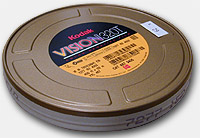 I
wanted to have the least amount of film grain as reasonably
possible. I had done some film tests with Kodak 100, 200,
320 and Fuji 125 asa film stock. Once transferred to BetaSP
and letterboxed for Super 16mm, I really didn't notice any
difference between the Kodak 100 and 200. The 320 maybe had
a tiny bit more grain, and the Fuji didn't look too different
from the Kodak stuff. (Some cinematographers make a big deal
on choosing Kodak or Fuji. When I shot some tests outside
with the Fuji, it did have more saturated greens than Kodak.)
The nice part about the Kodak 320 was that I had 2 more f-stops
than the 100 speed film. I ended up shooting Kodak
320T (7277) because I found 20 rolls of the stuff on rec.arts.movie.production!
(Journal entry
October 17, 1999) I
wanted to have the least amount of film grain as reasonably
possible. I had done some film tests with Kodak 100, 200,
320 and Fuji 125 asa film stock. Once transferred to BetaSP
and letterboxed for Super 16mm, I really didn't notice any
difference between the Kodak 100 and 200. The 320 maybe had
a tiny bit more grain, and the Fuji didn't look too different
from the Kodak stuff. (Some cinematographers make a big deal
on choosing Kodak or Fuji. When I shot some tests outside
with the Fuji, it did have more saturated greens than Kodak.)
The nice part about the Kodak 320 was that I had 2 more f-stops
than the 100 speed film. I ended up shooting Kodak
320T (7277) because I found 20 rolls of the stuff on rec.arts.movie.production!
(Journal entry
October 17, 1999)
I've been over-exposing
my film by almost a full f-stop. Everything looked kinda dark
when I shot my first roll set to the proper aperture setting.
I was also getting noticeable grain when they did the transfer
to video. By overexposing slightly, you get a little more
contrast and less grain. (You see what happens when a video
guy shoots film? He LIKES to see the images contrasty, just
like what he gets from his video rig!) :-P
03/02/01 - An
update on filmstocks: Guess what? At this point I've now
shot over 40 rolls of film in plenty of film stocks. Kodak
320T 7277 sucks for what I'm doing. Here's some things I've
learned during the past year while hanging out at alt.movies.cinematography:
Kodak T320 7277 is a low contrast film. (It's made that way)
If you want it to look "normal", you've got to over-expose
it a full stop. (as so I've learned the hard way). It's also
has a thinner emulsion than "regular" film stock.
It's more prone to scratching. (as so I've also learned the
hard way.)
My recommendation:
if you're going to shoot an indie (and at least attempt to
LIGHT the thing), get Kodak 200T 7274. Over-expose it half
a stop. It'll look great. You put an 85 filter over your lens
when your outdoors and you'll be fine. When you start to lose
light, pop the 85 filter off and you'll get a bonus 2 stops
at the end of the day to play around with. 320T is dumb, you
gotta over-expose a full stop, so yer at the same aperature
as if you shot 200T. Go figure. :-P
Light
meter: Spectra Pro IV-A
 The
Spectra
Pro IV-A seems to be one of the industry standards. What's
amazing is that there are a lot of light meters out there, but
not a lot of them do the standard film shutter rates. Only a
few light meters are designed for these settings. Sekonic also
does a light meter called the Mulitmaster 508c which deals with
cinematography settings. The
Spectra
Pro IV-A seems to be one of the industry standards. What's
amazing is that there are a lot of light meters out there, but
not a lot of them do the standard film shutter rates. Only a
few light meters are designed for these settings. Sekonic also
does a light meter called the Mulitmaster 508c which deals with
cinematography settings.
Audio
recording: Tascam DA-P1 DAT machine.
 The
Tascam DA-P1
has XLR inputs, records at 44.1 & 48k and has phantom power.
I wanted a DAT machine that records at 44.1 so I could record
other things like music without having to resample the audio
when digitally transferring it into a computer. (The Sony TCD-D10
Pro II DAT machine ONLY records at 48k!) Both of these machines
do not have time code. This isn't a problem with me because
I can easily re-sync any audio discrepancy on my non-linear
editing system. This desk put me out $1200 from B&H Photo/Video.
A time code DAT will easily put you out 3 grand. (My ACL camera
cannot deal with timecode anyways...so what's the point?) The
Tascam DA-P1
has XLR inputs, records at 44.1 & 48k and has phantom power.
I wanted a DAT machine that records at 44.1 so I could record
other things like music without having to resample the audio
when digitally transferring it into a computer. (The Sony TCD-D10
Pro II DAT machine ONLY records at 48k!) Both of these machines
do not have time code. This isn't a problem with me because
I can easily re-sync any audio discrepancy on my non-linear
editing system. This desk put me out $1200 from B&H Photo/Video.
A time code DAT will easily put you out 3 grand. (My ACL camera
cannot deal with timecode anyways...so what's the point?)
Microphone:
Sennheiser MKH-50
 There
are a lot more cheaper shotgun microphones out there, but
boy does this baby sound nice! The Sennheiser
MKH-50 really isn't a shotgun mic, but a hyper-cardiod
microphone. (It has a little wider pattern than typical shotgun,
but isn't nearly as long physically.) This puppy will run
you about a grand from B&H Photo/Video, but since I wanted
one good microphone to do everthing, (Voice over works, foley
stuff, etc.) I decided to go with this. The other option would
be do get a Schoeps MK 41/CMC 6/Cut 1 rig. This mic comes
in 3 parts and will put you back about 2 grand new. The Schoeps
is generally considered the best for film work. (I think I'll
settle for next best.) There
are a lot more cheaper shotgun microphones out there, but
boy does this baby sound nice! The Sennheiser
MKH-50 really isn't a shotgun mic, but a hyper-cardiod
microphone. (It has a little wider pattern than typical shotgun,
but isn't nearly as long physically.) This puppy will run
you about a grand from B&H Photo/Video, but since I wanted
one good microphone to do everthing, (Voice over works, foley
stuff, etc.) I decided to go with this. The other option would
be do get a Schoeps MK 41/CMC 6/Cut 1 rig. This mic comes
in 3 parts and will put you back about 2 grand new. The Schoeps
is generally considered the best for film work. (I think I'll
settle for next best.)
03/02/01 - An
update on this microphone: I still love this microphone.
I've been using it to do everything. It blows away the crappy
shotguns that I've used. (older ME-66, AT 835b) Be warned:
if you are going to shoot outdoors, even with the foam windscreen
on it, you'll still be getting wind noise. You'll need a zeppelin/blimp.
I'm considering getting the MKH-70 full shotgun at some point.
(just to deal with the VERY noisey situations.)
03/15/01 - M-S
Stereo ambient recording: I needed to record a bunch of
ambient background stuff (for almost all the scenes in this
production) and I wanted to do some clean stereo recordings.
I bought an AKG
SE300/CK94 combo which uses a figure-eight recording pattern.
To learn more about how to record M-S stereo ambients, click
on the link below.
 - How to record
M-S stereo for film or whatever.
- How to record
M-S stereo for film or whatever.
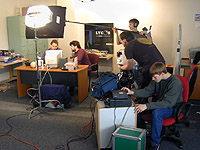 (4)
Arri 1K openfaces, (1) 650 watt Lowel Tota light, (1) Arri
650 watt open-face, (1) 100 watt pepper, (2) Chimera soft
boxes (w. speed rings), (2) very old C-stands, (1) foldable
Chimera frame (with diffusion + reflection material), (2)
small felt flags, (4) crappy, shakey Lowel light stands +
assorted AC extensions. (4)
Arri 1K openfaces, (1) 650 watt Lowel Tota light, (1) Arri
650 watt open-face, (1) 100 watt pepper, (2) Chimera soft
boxes (w. speed rings), (2) very old C-stands, (1) foldable
Chimera frame (with diffusion + reflection material), (2)
small felt flags, (4) crappy, shakey Lowel light stands +
assorted AC extensions.
"Weee don't need
no stinkin' GRIP TRUCK!"
My motto: if you
can't light it with (2) 1K's with softboxes, then don't film
it! :-P
03/02/01 - An
update on lighting: The few times I had a real lighting
guy, I was able to shoot twice as quickly My advice: find
ANYBODY who can at least set up the lights in at least a vaguely
competent manner. Pay/beg/plead/go down on this person to
help you. After you've found a lighting guy, a competent sound
person, THEN think about a camera person.
Post Production: Media 100 2.6.2 (older Nubus version)
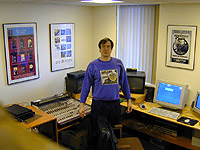 All
my film is transferred to BetaSP letterboxed. I digitize the
audio in from a Panasonic sv-3700 DAT machine. The video gets
digitized from a smelly Sony UVW-1800 through a component cable
into the Media 100. Syncing the audio and video to the clapper
is a breeze. Any foley/ADR work can easily be looped from the
Media 100 and will be recorded with my spiffy Sennheiser MKH-50
microphone back onto the Tascam DA-P1 machine. All
my film is transferred to BetaSP letterboxed. I digitize the
audio in from a Panasonic sv-3700 DAT machine. The video gets
digitized from a smelly Sony UVW-1800 through a component cable
into the Media 100. Syncing the audio and video to the clapper
is a breeze. Any foley/ADR work can easily be looped from the
Media 100 and will be recorded with my spiffy Sennheiser MKH-50
microphone back onto the Tascam DA-P1 machine.
|
